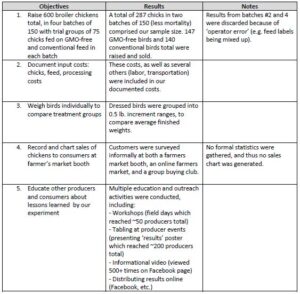Project Overview
Commodities
- Animals: poultry
Practices
- Animal Production: animal protection and health, genetics
Summary:
Our project sought to address the following questions:
1. Given a standardized ration and environmental conditions, what is the input cost comparison between GMO-free and conventional feed to pasture raise Cornish cross broilers?
2. Given a standardized hatch to slaughter timeline (seven weeks), how does the dressed weight compare between these treatment groups?
3. Are consumers willing to pay more at a farmer’s market for chickens raised on GMO-free feed?
High-level findings were:
- Feed consumption per bird was lower in the GMO-free fed birds; however, total cost of feed per bird was higher given the higher cost of GMO-free feed.
- Total input costs per bird were approximately 12% higher for the GMO-free broilers.
- Average dressed weight of broilers was slightly lower, on average, for the GMO-free broilers.
- Consumers had a slight preference for GMO-free birds when presented with a choice, despite a higher price point.
Introduction
For the 2015 growing season Berggren Demonstration Farm (now Phoenix Farm Enterprises, Inc) received a WSARE Farmer and Rancher Grant to perform a side-by-side comparison of pasture-raised Cornish Cross broilers fed on GMO-free feed vs. conventional feed. We raised three batches of birds under experimental conditions, tracking feed costs, labor inputs, transportation, and dressed weight at processing. At point of sale, we informally surveyed consumers to evaluate preferences for GMO-free vs. conventionally fed birds, with a higher cost-per pound price assigned to the GMO-free birds to account for higher feed costs.
We originally proposed to conduct three trials of 50 chicks each, with 25 chicks on conventional feed and 25 on GMO-free. Ultimately we decided to run four trials of 150 birds, with 75 birds in each group. Due to problems with the two of the trials we are reporting of the results of two of the trials, # 1 and #3, with discussion of all of the trials.
Project objectives:
We modified our original objectives to increase the total sample size for the experiment. Objectives and performance targets are as follow:
